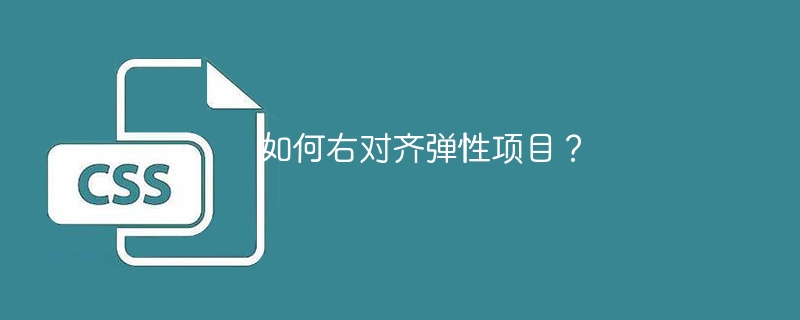

CSS is a powerful module used by web designers to control the visual layout of a website. One of the most commonly used visual layouts in web design is the use of flex-box to create flexible and dynamic web layouts. It provides a simple and effective way to align items within a container in different ways, including right-aligning flex items.
First we need to understand what flex-box is. Flex-box is a CSS layout module that provides a flexible way to create layouts for different screen sizes and devices. It is built around two main concepts: the first is a flex container, which is a parent element that contains one or more flex items; the second is a flex item, which is a child element of a flex container. The container element uses a set of CSS properties to control the layout of flex items.
Flexbox works by defining a container element and its children as flex items. Container elements are defined using the display: flex; attribute, which enables flexible layout mode. The child elements are then positioned and aligned inside the container using a set of flex properties.
Some of the most commonly used flexbox properties include -
justify-content - Used to align flex items along the main axis of the container
align-items - Used to align flex items along the horizontal axis of the container
flex-direction − Used to define the main axis direction of the container (horizontal or vertical)
flex-wrap - This is used to define how flex items should be wrapped inside the container
flex-grow - This is used to specify how much the item should grow to fill the available space
flex-shrink - It is used to specify how much the item should shrink to fit the available space
Right aligning flex items means placing them on the right side of the container. There are several ways to achieve this with CSS, in this article we will explore two ways to achieve this -
justify-content property is used to align flex items along the main axis of the container. To right-align the items, we set the value of justify-content to flex-end.
In the example below, we have a container with three child elements, each with a class named child. To create a right-aligned flex item, we add another class called right-align to the third item. In CSS, we set the display property of the container to flex to enable flexbox layout. We then use the justify-content property to distribute the items on the main axis and add spacing between them. Finally, we use the margin-left: auto property to push the right-aligned item to the right edge of the container.
<!DOCTYPE html>
<html>
<head>
<style>
body { text-align: center; }
.my-container {
display: flex;
justify-content: space-between;
background-color: lightgray;
}
.child {
background-color: green;
color: #fff;
padding: 5px;
margin: 3px;
}
.right-align { margin-left: auto; }
</style>
</head>
<body>
<h3>Right-aligning flex using justify-content property</h3>
<div class="my-container">
<div class="child">Item 1</div>
<div class="child">Item 2</div>
<div class="child right-align">Item 3</div>
</div>
</body>
</html>
align-self attribute is used to align a single flex item along the cross axis of the container. To right align a specific item, we set the value of align-self to flex-end.
In the example below, we have a container with three child elements, each container child element has a class named child. To create a right-aligned flex item, we add another class called right-align to the third item. In CSS, we set the display property of the container to flex to enable flexbox layout, and set the flex-direction property to column, to stack items vertically. We also set the width of each item to 100% to ensure that they take up the entire width of the container.
To align the third item to the right, we use the align-self property on the right-aligned item and set its value to flex-end. This tells the item to align itself on the cross axis to the end of the container.
<!DOCTYPE html>
<html>
<head>
<style>
body { text-align: center; }
.my-container {
display: flex;
flex-direction: column;
background-color: lightgray;
}
.child {
background-color: red;
color: #fff;
margin: 3px;
padding: 5px;
}
.right-align { align-self: flex-end; }
</style>
</head>
<body>
<h3>Right-aligning flex using align-self property</h3>
<div class="my-container">
<div class="child">Item 1</div>
<div class="child">Item 2</div>
<div class="child right-align">Item 3</div>
</div>
</body>
</html>
In CSS, you can easily right-align Flex items using Flexbox. By defining the container element as a Flex container and setting the appropriate CSS properties, we can create flexible and dynamic web layouts that adapt to different screen sizes and orientations.
The above is the detailed content of How to right align flex items?. For more information, please follow other related articles on the PHP Chinese website!




